With Robert Recorde (c. 1510–1558) and John Dee (1527–c. 1608), we have already looked at two mathematical practitioners, who were among the first to publish mathematical texts in the vernacular in sixteenth century England. A third member of this group was Leonard Digges (c.1515–c. 1559) who was a friend of Dee’s. Usually, if Leonard is known at all, it is as the father of Thomas Digges (c. 1546–1595) a much more famous mathematical practitioner, who actually published more of Leonard’s work than he himself did, and who we will look at in a separate post. However, today we are going to pull Leonard into the limelight.
Leonard was born into an influential, wealthy landowning family in Barham in the county of Kent.
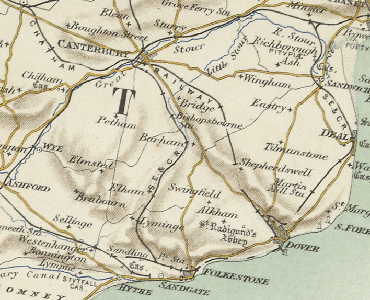
Both his grandfather John Digges and his father James Digges (b. 1473) had served as High Sheriff of Kent–John 1495–6 and James 1510–11. Leonard was the issue of James’ second marriage with Phillippe Engham daughter of John Engham of Chart in Kent. He had an elder brother John the issue of James’ first marriage to Mildred Fineux the daughter of Sir John Fineux, Chief Justice of the King’s Bench.
There are indications that Leonard studied at Oxford. In a letter, which his father wrote in 1531, he talks about maintaining his son at Oxford and his grandchildren, that would be his son John’s children, at school, but there are no surviving records of Leonard having studied there. It is, however, known that he entered Lincoln’s Inn in 1537. Unlike his father and grandfather there is no record of Leonard having held county office. He was named as one of those charged with defending the Kent coast from Dover to Folkstone in 1545 and was also listed as a supporter of Sir Thomas Wyatt the younger’s scheme for a militia.
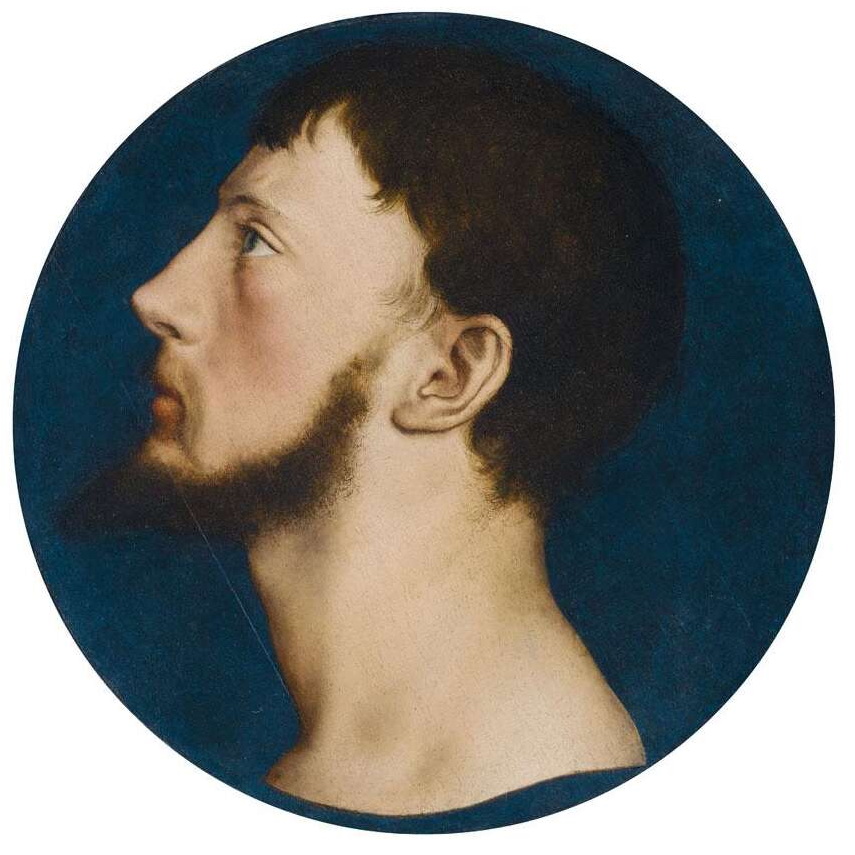
Unfortunately, his association with Sir Thomas Wyatt the younger (1521–1554) would lead him into major problems. Wyatt, a major Kent landowner, was one of the leaders of what is traditionally called “Wyatt’s Rebellion” in 1554. This was an unsuccessful insurgency of Protestant landowner against Queen Mary’s plans to marry Philip of Spain. Leonard had joined Wyatt’s Rebellion and after it was defeated he was tried for high treason, attainted, and sentenced to death. He was pardoned on 1 April 1554 but ‘his lands and goods, which had been seized after his attainder, continued to be held subject to payment of recognizances to the crown’. In February 1555 Digges was fined 400 marks. After being paid off in instalments, the fine was discharged on 7 May 1558. The date of Digges’ death is unknown; he is thought to have died about 1559.
Leonard married Bridget, daughter of Thomas Wilford of Kent, and they had at least three sons and four daughters, Thomas being the eldest son.
As a mathematical practitioner, Leonard first made an appearance when in 1542, in the company of three other gentlemen, he visited the castle of Guînes in the Pas-de-Calais, ‘where they impressed their host through debate and demonstration of their skills in geometry, navigation, measurement, and artillery.’
Leonard wrote quite extensively on a wide range of mathematical topics but only two of his works are known to have been published during his lifetime. The first of these was his almanac, A Prognostication of Right Good Effect, Fruitfully Augmented published in 1555.
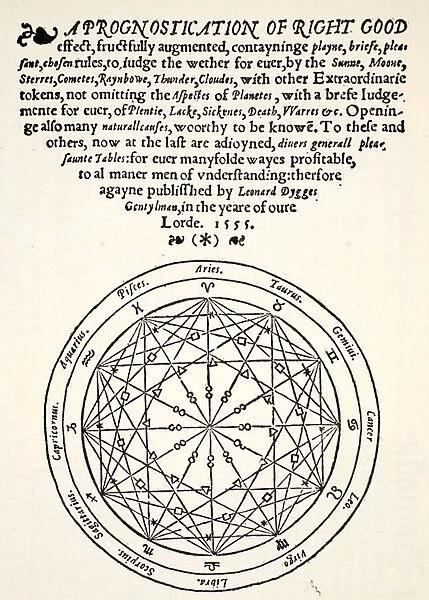
This almanac was dedicated to Sir Edward Fiennes, Lord Clinton and Sayle (1512–1584) (who later became Lord High Admiral of England), who was thanked for his help in preserving Digges during his “troubles.” Digges described the 1555 text as a revision and expansion of a now lost earlier version referred to as his “general prognostication,” printed in 1553. It is probably not a coincidence that Digges’ 1553 almanac was issued at the same time as John Dee’s Astronomicall and Logisticall Rules written for Willoughby and Chancellor expedition to search for the Northeast Passage in 1553, in which Stephen Borough (1525–1585) took part. After 1555 there were at least thirteenth further editions of Leonard’s almanac up into the early seventeenth century, generally under the title A Prognostication Everlasting, From 1576,. They were edited with additions by his son Thomas.
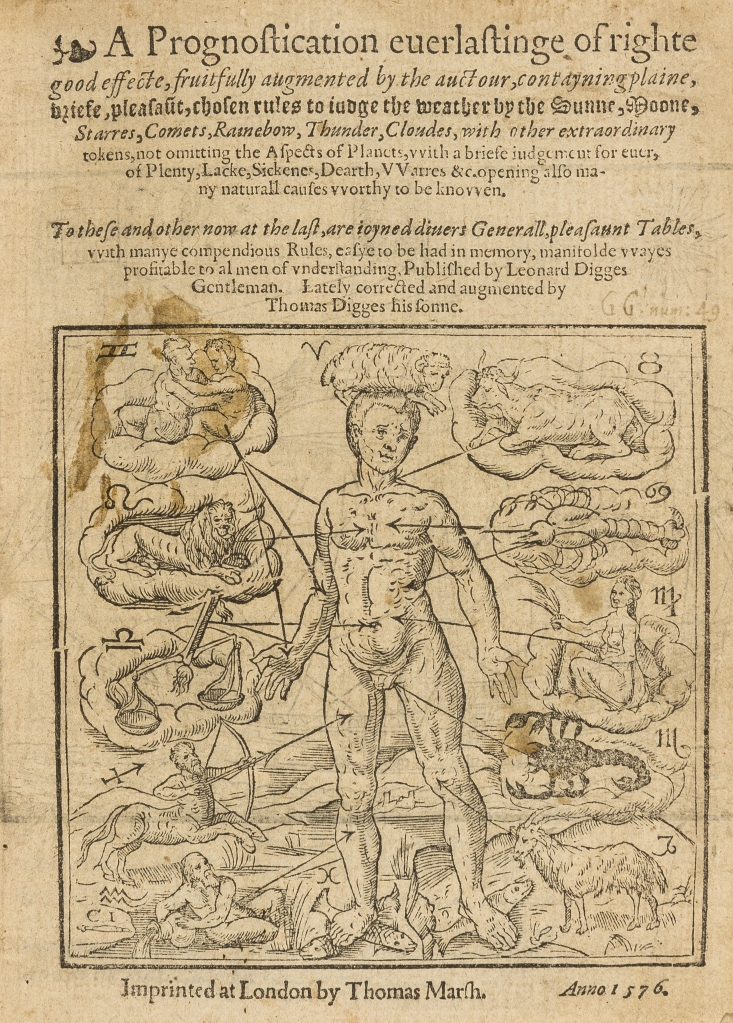
Leonard’s almanac was not the usual astrological text issued every year but contained material of a more generally valid nature. Fragments of a single sheet almanac for Kent for 1556 show that he also catered for that market. The preface to the Prognostication consisted of an apology for astronomy and the mathematical sciences quoting both Melanchthon (1479–1560), a major promotor of astronomy, mathematics, and astrology, as well as Guido Bonatus (died between 1296 and 1300), Italian astronomer, mathematician, and the most celebrated thirteenth century astrologer. The Prognostication contains calendrical tables, and explanations of meteorological phenomenon, basic astrological information and rules for predicting the weather, as well as times for planting, grafting, and bloodletting. He discussed the use of instrument such as the quadrant and square for time telling and, as noted above, tide tables for mariners. Later editions included diagrams of the geocentric world system and the relative sizes of the planets. In his preface Leonard also recommended the mathematical sciences for their pleasure as well as their utility:
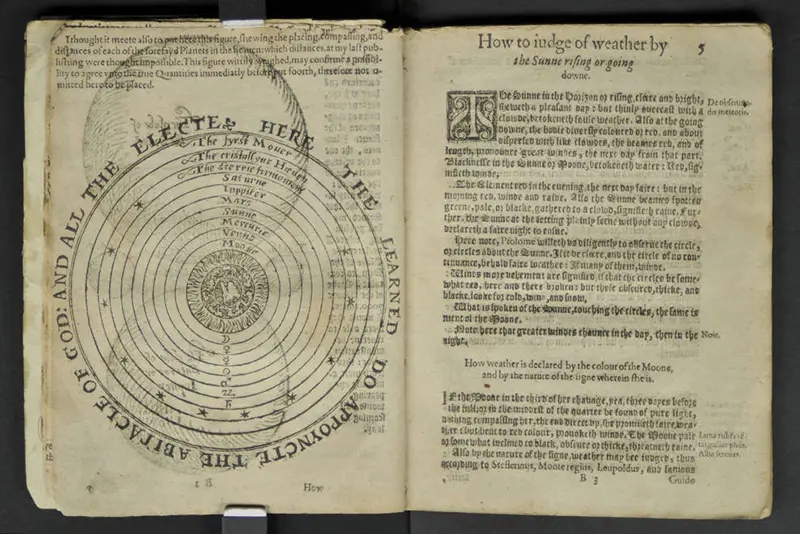
‘the ingenious learned and well experienced circumspect student mathematical receiveth dail in his witty practices more pleasant joy of mind than all thy goods (how rich however thou may be) can at any time purchase’ (Prognostication 1555)
The second book issued in his lifetime was his A Booke Named Tectonicon published in 1556.
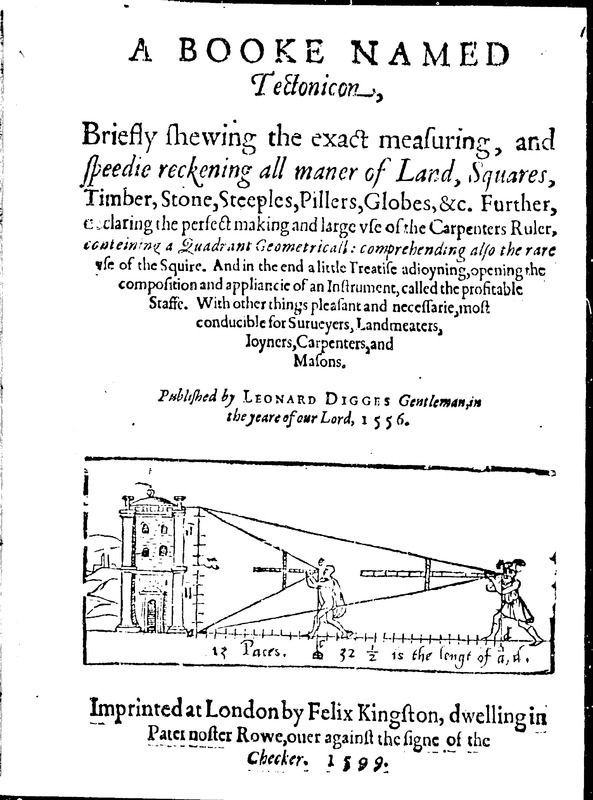
It was advertised on its title page as a book for surveyors, ‘landmeters’, joiners, carpenters and masons. This book taught the reader how to measure land, calculate quantities, and to use instruments such as the carpenter’s rule, the square, and a version of the cross-staff (‘the profitable staff’). Digges emphasised the correction of common errors practiced by those without a solid grounding in mathematics. This theme of ‘vulgar errors’ became standard in many subsequent mathematical texts. See, for example, Certaine Errors in Navigation by Edward Wright (1561–1615) published in 1599. Tectonicon was immensely successful with a least twenty printed editions, the last in 1692. The text was also the start of the commercial trade in mathematical instruments in England. It was published by the Flemish immigrant, instrument maker Thomas Gemini (c. 1510–1562), who also published Digges’ almanac, advertised on the title page, his ability to supply all of the instruments mentioned in the book:
‘Imprented at London in ye Blackfriers by Thomas Gemine, who is ther ready exactly to make all the Instruments apertaining to thes booke.’
Thomas Gemini was probably the first to establish a commercial instrument workshop in London.
In his publications, Leonard announced further works, a larger work on the use of the square, expanding on the description in Tectonicon, a treatise on the construction of the letters of the alphabet, possibly influenced by Dürer’s Underweysung der Messung mit dem Zirckel und Richtscheyt (1525), a book on astrology, and a major work on practical mathematics. Only the latter was realised with his A Geometrical Practice Named Pantometria, which was published by his son Thomas in 1571, with a second edition in 1591. This was heavily informed by the work of both Peter Apian (1495–1552) and Gemma Frisius (1508–1555) and it contained the first description in English of many of the instruments and techniques.
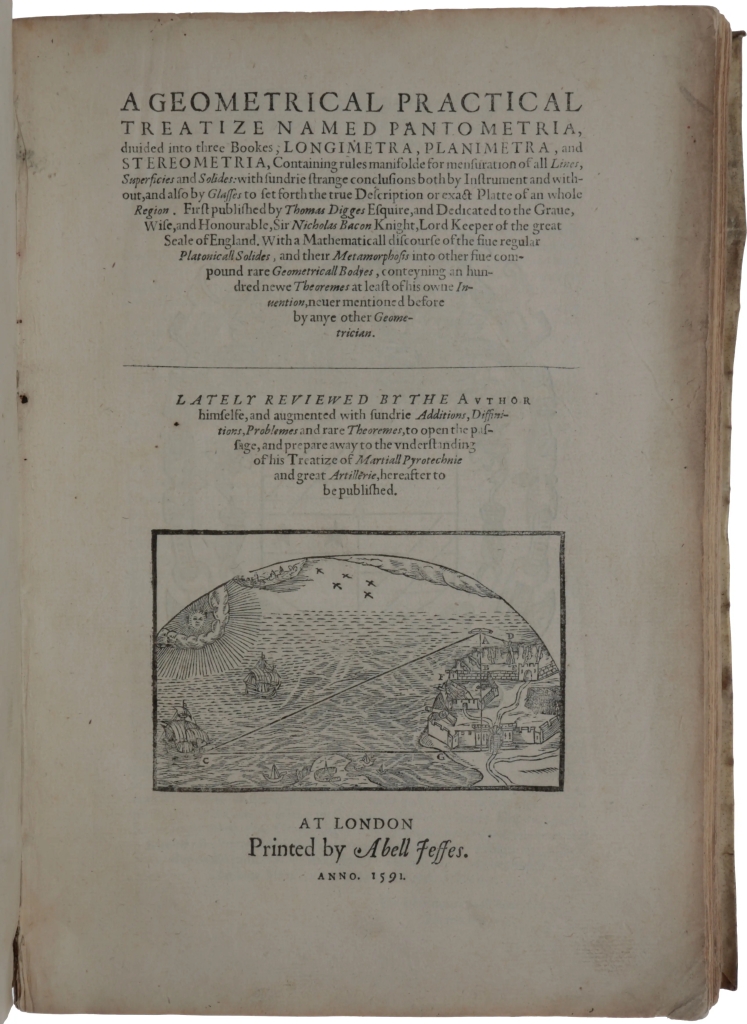
The complete title of the book is, as is so often the case with sixteenth century publications, a short essay in itself:
A geometrical practise, named Pantometria diuided into three bookes, longimetra, planimetra, and stereometria, containing rules manifolde for mensuration of all lines, superficies and solides: with sundry straunge conclusions both by instrument and without, and also by perspectiue glasses, to set forth the true description or exact plat of an whole region: framed by Leonard Digges gentleman, lately finished by Thomas Digges his sonne. Who hathe also thereunto adioyned a mathematicall treatise of the fiue regulare Platonicall bodies, and their Metamorphosis or transformation into fiue other equilater vniforme solides Geometricall, of his owne inuention, hitherto not mentioned of by any geometricians
Pan means all or universal , so we can assume that the title Pantometria means all or all forms of measurement. This is confirmed by the titles of the three book: longimetria, which we are told is the mensuration of all lines
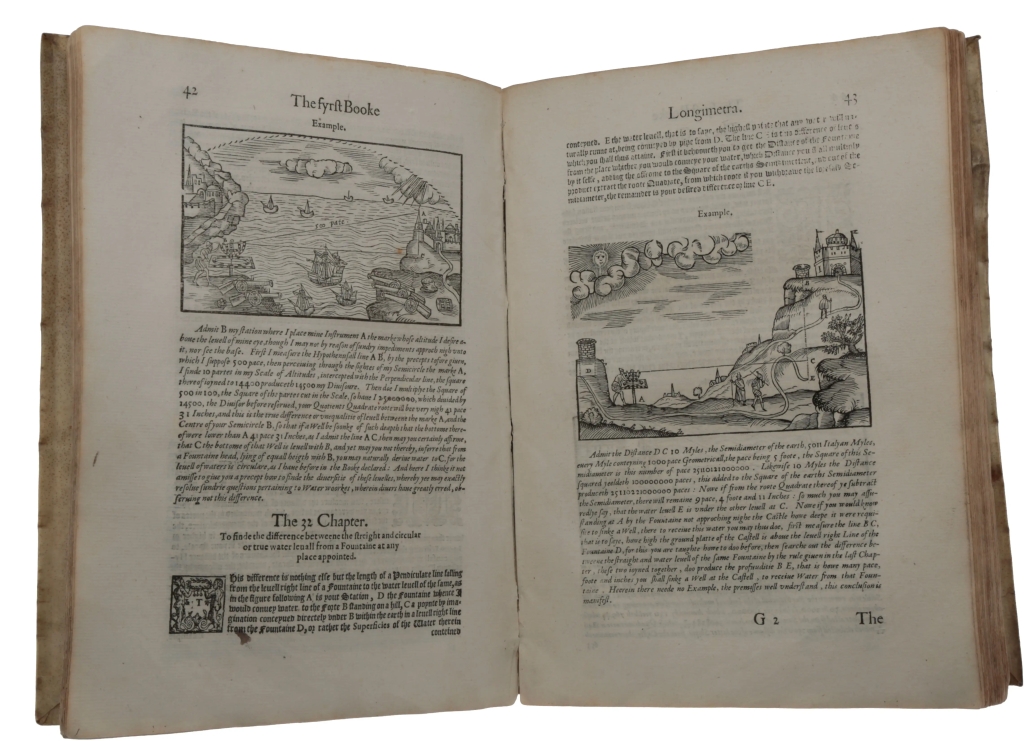
planimetra, which we are told is the mensuration of all superficies, in modern English surfaces, or put another way polygons
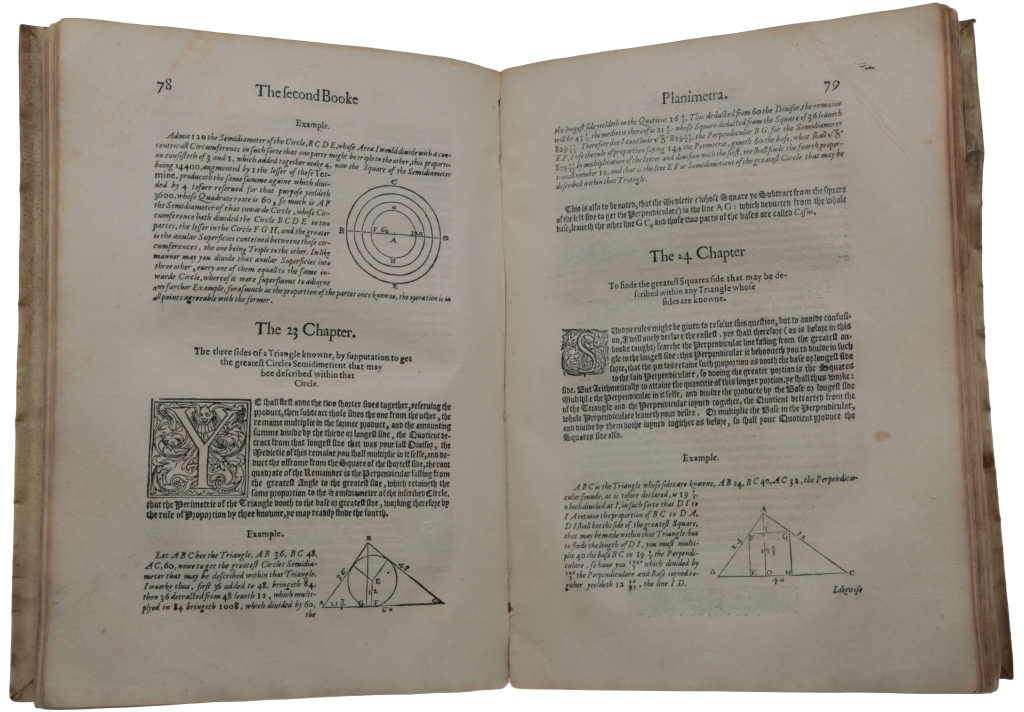
stereometria, we are told is the mensuration of all solids, still in use as stereometry the measurement of volume.
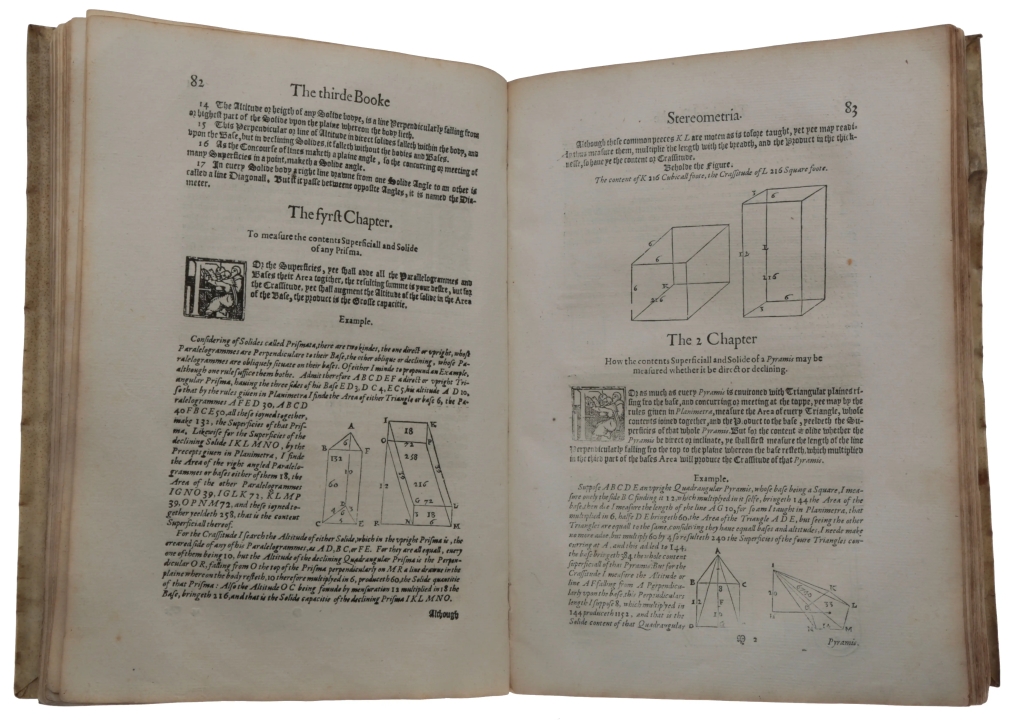
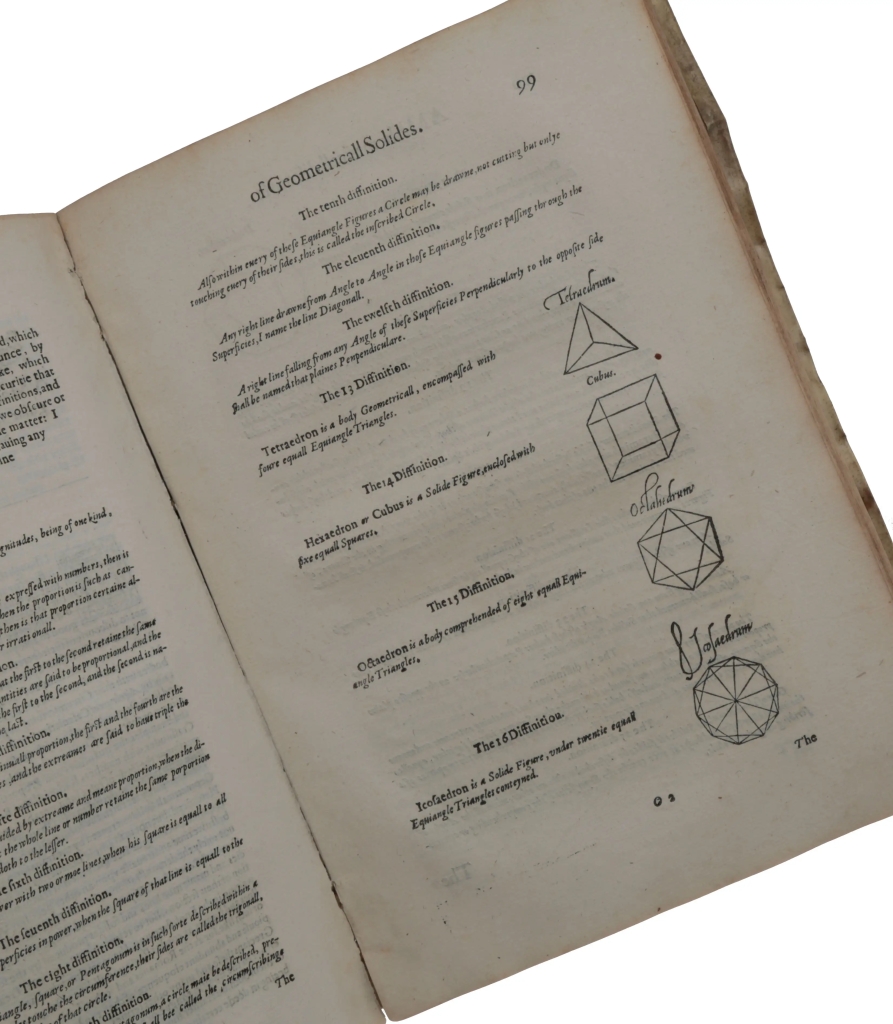
The first book is a more advance treatise on surveying than his Tectonicon but interestingly the Pantometria only had two editions, as opposed to the twenty plus edition of the simpler text. The Pantometria is famous for two inventions, firstly the theodolite and secondly, according to some historians, some sort of telescope.
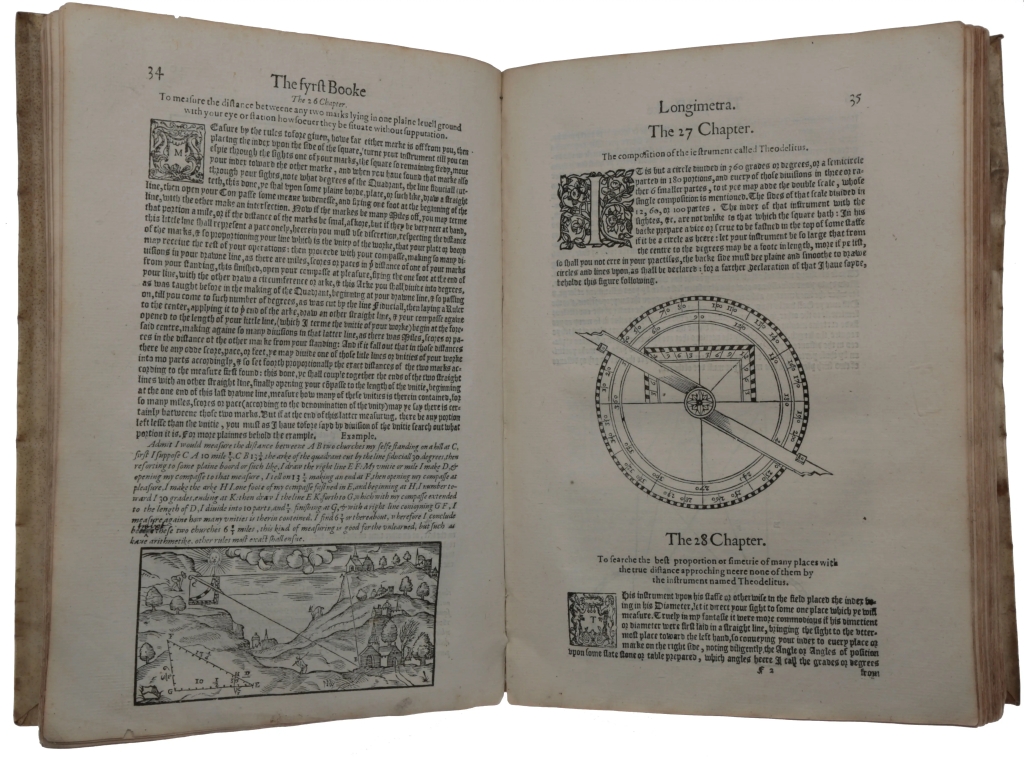
The theodolite is one of the scientific instruments that people get to see almost daily, on building sites, road works, or land surveying. The modern instruments has, of course, very little in common, beyond the basics, with the instruments out of the sixteenth century. What is a theodolite?
A theodolite is a precision optical instrument for measuring angles between designated visible points in the horizontal and vertical planes. (Wikipedia)
Before there were theodolites there were various instrument combining some sought of sights with a graduated circle or semi-circle for measuring either vertical or horizontal angles. The clue in the theodolite was combing both functions in a single instrument. The word theodolite first occurs in Leonard’s Pantometria and the etymology of the term is not clear. Interestingly he here uses it for an instrument that only measures horizontal angles. However, he also describes an instrument that measures both vertical and horizontal angles, which he called a topographical instrument. The earliest instrument halfway recognisable as a theodolite was from the German instrument maker Josua Habermel (dates unknown) in 1576.
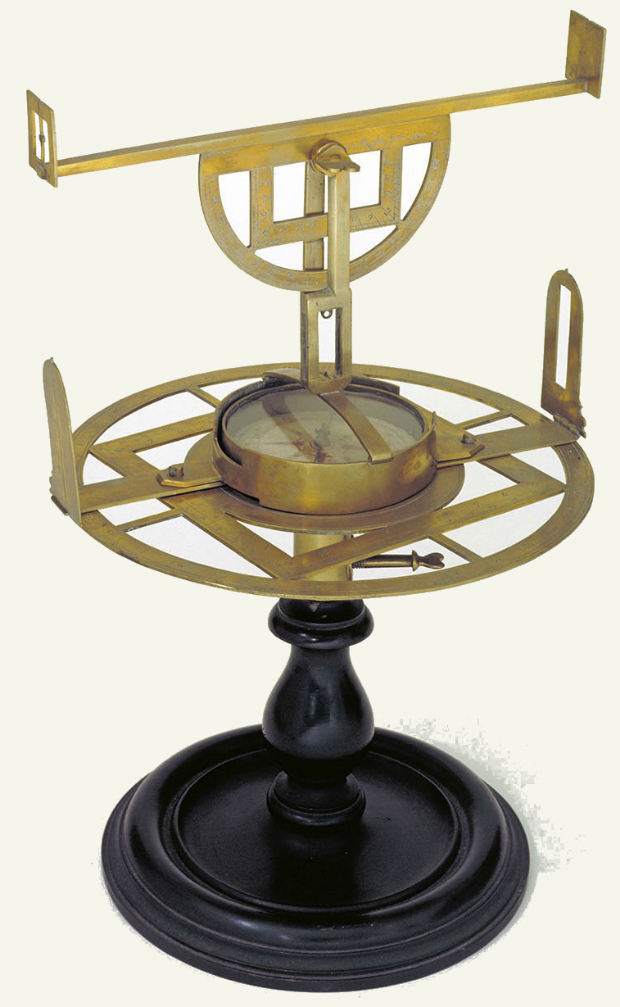
Much ink has been spilled over the supposed Digges’ telescope and I wrote a fairly full account of the story on my post about William Bourne (c. 1535–1582), so I’m just going to cut and paste it to here.
There is a more extensive text on optics from Bourne A treatise on the properties and qualities of glasses for optical purposes, according to the making, polishing, and grinding of them, which only exists in manuscript and was never published. It was dedicated to William Cecil, 1st Baron Burghly, Lord High Treasurer, who had apparently questioned Bourne on the topic. Albert Van Helden in his Invention of the Telescope (American Philosophical Society, 1977) describes it as “a very useful review of the state of the art” and you can read the whole text in Van Helden’s book. In the final part of the text Bourne writes:
For that there ys dyvers in this Lande, that can say and dothe know muche more, in these causes, than I: and especially Mr. Dee and also Mr. Thomas Digges, for that by theyre Lerninge, they have read and seene moany moo [sic] auctors in these causes…
[…]
And so yt ys possible, that yt may bee hepped and furdered the one glasse with the other, as the concave looking glasse with the other gounde and polished glasse. That yt ys likely yt ys true to see a smalle thing, of a very greate distance. For that that the one glasse dothe rayse and enlarge, the beam of the other so wonderfully. So that those things that Mr. Thomas Digges hathe written that his father hathe done, may bee accomplished very well, withowte any dowbte of the matter : But that the greatest impediment ys, that yow can not beholde, and see, but smaller quantity at a tyme.
The text of Thomas Digges that Bourne is referring to is in his completion and publication of his father’s book Pantometria in 1571:
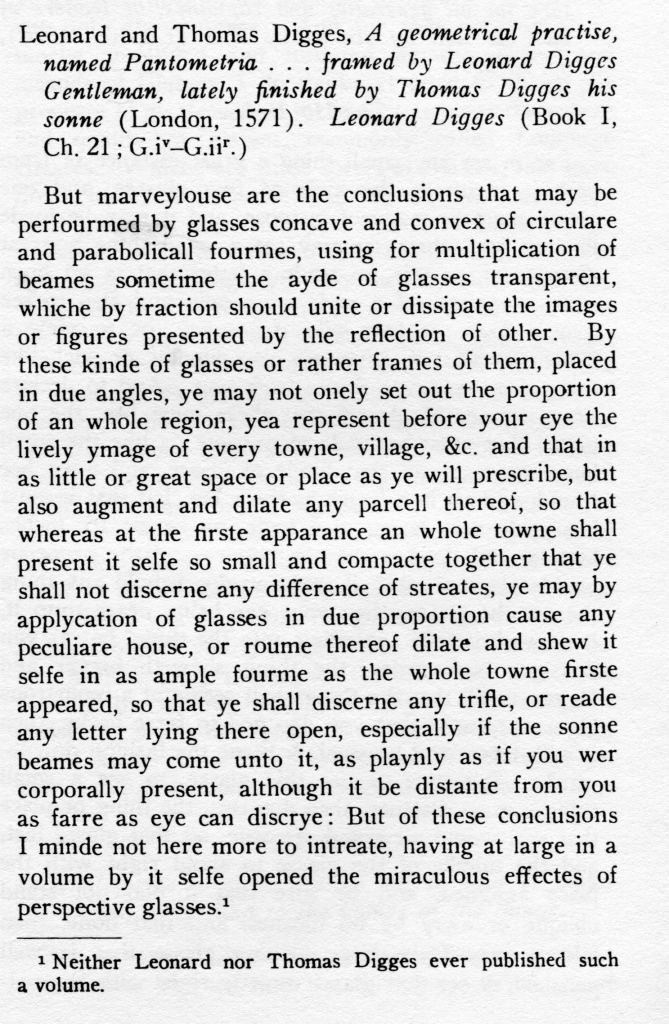
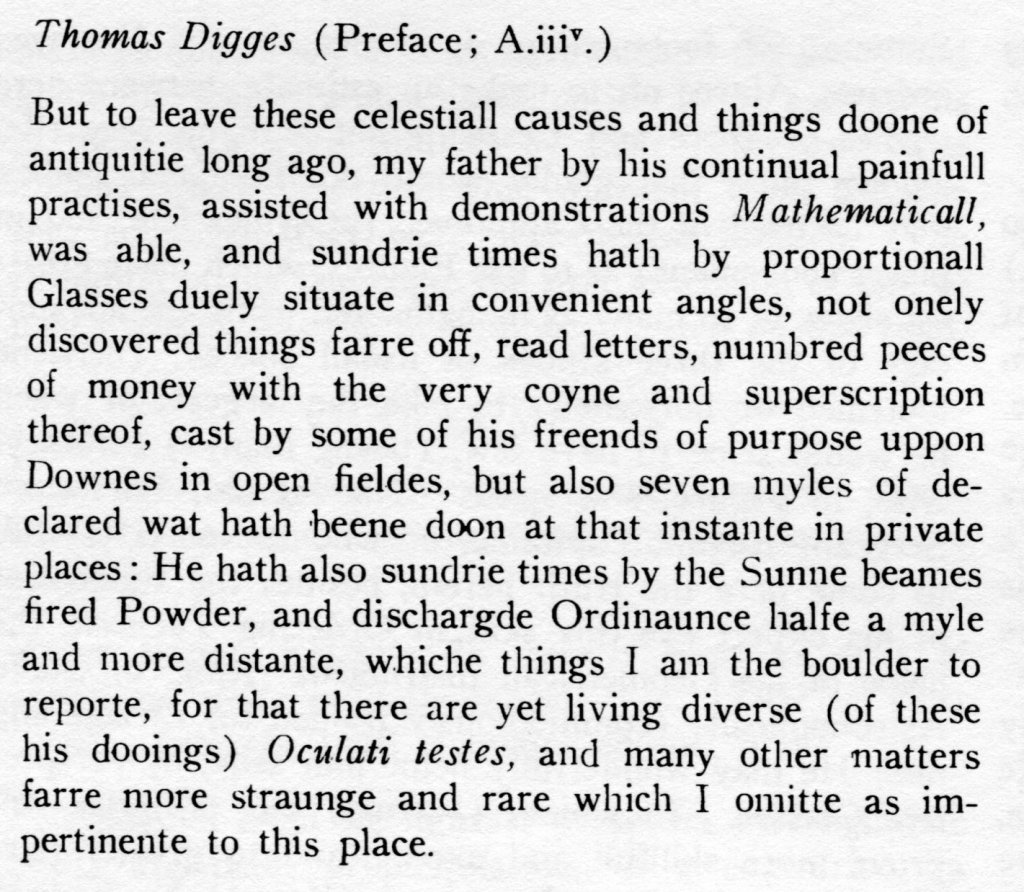
The combination of the Digges’ text and Bourne’s elucidation of it has led some historian of science, most notably Colin Ronan (1920–1995), to claim that the Digges invented a reflecting telescope but both Fred Watson (in his book Stargazer: the life and times of the Telescope (Da Capo Press, 2004) ) and Van Helden dismiss this claim, arguing that they lacked to necessary technical ability to produce lenses and mirrors of the required quality.
The final book to bear Leonard’s name his Stratioticos was actually written by Thomas but was partially based on Leonard’s research notes into artillery and ballistics. There were two editions in 1579 and 1590.
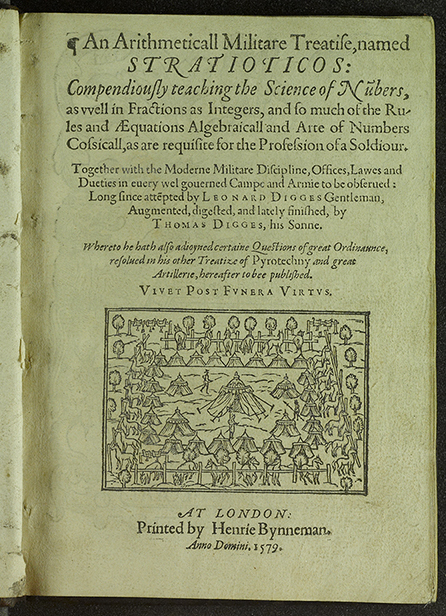
Once again we have a magnificent title:
An Arithmeticall Militare Treatise, named
STRATIOTICOS
Compendiously teaching the Science of Nu[m]bers,
as vvell in Fractions as Integers, and so much of the Rules and Æquations Algebraicall and Arte of Numbers Cossicall, as are requisite for the Profession of a Soldiour.
Together with the Moderne Militare Discipline, Offices, Lawes and Dueties in euery wel gouerned Campe and Armie to be obserued
Long since attepted by Leonard Digges Gentleman,
Augmented digested, and lately finished, by
Thomas Digges, his Sonne.
Whereto he hathe also adionyned certaine Questions of great Ordinance,
resolved in his other Treatise of Pyrotechny and great
Artillerse, hereafter to bee published
Vivet Post Fvnera Virtvs
Leonard’s research, probably inspired by his involvement in Sir Thomas Wyatt the younger’s scheme for a militia, was based around Niccolò Tartaglia’s Nova scientia (1537) the first mathematical book on ballistics. Leonard researched the topic both theoretically and practically and came to the conclusion that some of Tartaglia’s most important result were incorrect. This is the first mathematical treatise on ballistics in English.
As can be seen from the sources that he used to write his books, Leonard Digges was well informed and widely read. Although he is, today, less well known than both John Dee and his son Thomas, Leonard made a major contribution to introduction practical mathematics in the vernacular for the common craftsmen, mariners and whoever, in the second half of the sixteenth century, his first two texts seeing many editions over a long period and reaching a very wide audience.